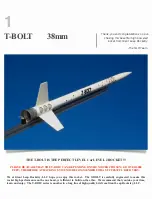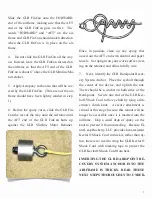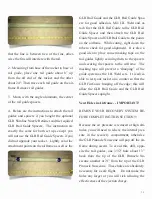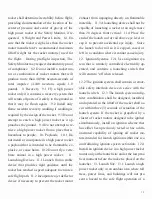
rocket shall determine its stability before flight,
providing documentation of the location of the
center of pressure and center of gravity of the
high power rocket to the Safety Monitor, if re-
quested. 8. Weight and Power Limits. 8.1 En-
sure that the rocket weighs less than the rocket
motor manufacturer's recommended maximum
liftoff weight for the rocket motor(s) used for
the flight. During pre-flight inspection, The
Safety Monitor may request documentary proof
of compliance. 8.2 Do not install a rocket mo-
tor or combination of rocket motors that will
produce more than 40,960 newton-seconds of
total impulse (4.448 newtons equals 1.0
pound). 9. Recovery. 9.1 Fly a high power
rocket only if it contains a recovery system that
will return all parts of it safely to the ground so
that it may be flown again. 9.2 Install only
flame resistant recovery wadding if wadding is
required by the design of the rocket. 9.3 Do not
attempt to catch a high power rocket as it ap-
proaches the ground. 9.4 Do not attempt to re-
trieve a high power rocket from a place that is
hazardous to people. 10. Payloads. 10.1 Do
not install or incorporate in a high power rocket
a payload that is intended to be flammable, ex-
plosive, or cause harm. 10.2 Do not fly a verte-
brate animal in a high power rocker. 11.
Launching Devices 11.1 Launch from a stable
device that provides rigid guidance until the
rocket has reached a speed adequate to ensure a
safe flight path. 11.2 Incorporate a jet deflector
device if necessary to prevent the rocket motor
exhaust from impinging directly on flammable
materials. 11.3 A launching device shall not be
capable of launching a rocket at an angle more
than 20 degrees front vertical. 11.4 Place the
end of the launch rod or rail above eye level or
cap it to prevent accidental eye injury. Store
the launch rod or rail so it is capped, cased, or
left in a condition where it cannot cause injury.
12. Ignition Systems. 12.1 Use an ignition sys-
tem that is remotely controlled, electrically op-
erated, and contains a launching switch that
will return to "off when released.
12.2 The ignition system shall contain a remov-
able safety interlock device in series with the
launch switch. 12.3 The launch system and ig-
niter combination shall be designed, installed,
and operated so the liftoff of the rocket shall oc-
cur within three (3) seconds of actuation of the
launch system. If the rocket is propelled by a
cluster of rocket motors designed to be ignited
simultaneously, install an ignition scheme that
has either been previously tested or has a dem-
onstrated capability of igniting all rocket mo-
tors intended for launch ignition within one sec-
ond following ignition system activation. 12.4
Install an ignition device in a high power rocket
motor only at the launch site and at the last prac-
tical moment before the rocket is placed on the
launcher. 13. Launch Site. 13.1 Launch a high
power rocket only in an outdoor area where tall
trees, power lines, and buildings will not pre-
sent a hazard to the safe flight operation of a
15



































